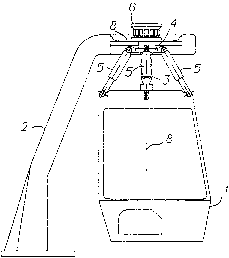Some of the information on this Web page has been provided by external sources. The Government of Canada is not responsible for the accuracy, reliability or currency of the information supplied by external sources. Users wishing to rely upon this information should consult directly with the source of the information. Content provided by external sources is not subject to official languages, privacy and accessibility requirements.
Any discrepancies in the text and image of the Claims and Abstract are due to differing posting times. Text of the Claims and Abstract are posted:
| (12) Patent: | (11) CA 2090319 |
|---|---|
| (54) English Title: | CABIN, ESPECIALLY FOR A CROSS-COUNTRY VEHICLE |
| (54) French Title: | CABINE, EN PARTICULIER POUR VEHICULE TOUT-TERRAIN |
| Status: | Expired and beyond the Period of Reversal |
| (51) International Patent Classification (IPC): |
|
|---|---|
| (72) Inventors : |
|
| (73) Owners : |
|
| (71) Applicants : |
|
| (74) Agent: | |
| (74) Associate agent: | |
| (45) Issued: | 2001-04-24 |
| (86) PCT Filing Date: | 1991-08-22 |
| (87) Open to Public Inspection: | 1992-03-19 |
| Examination requested: | 1997-10-06 |
| Availability of licence: | N/A |
| Dedicated to the Public: | N/A |
| (25) Language of filing: | English |
| Patent Cooperation Treaty (PCT): | Yes |
|---|---|
| (86) PCT Filing Number: | PCT/SE1991/000556 |
| (87) International Publication Number: | WO 1992004224 |
| (85) National Entry: | 1993-12-24 |
| (30) Application Priority Data: | ||||||
|---|---|---|---|---|---|---|
|
A cabin intended primarily for cross-country
vehicles and supported at the top thereof by a
carrier frame (2) mounted on the vehicle. The cabin
(1) is freely suspended from the carrier frame (2)
by means of a carrier device (3) which is so located
in relation to a vertical line which passes through
the centre of gravity of the cabin (1) that the cabin
will always be located essentially in the horizontal
plane. The cabin is also connected to the carrier
frame (2) by means of shock absorbers (5) which
are spaced from the carrier device.
Cabine destinée notamment aux véhicules tout-terrain et portée au niveau de son extrémité supérieure par un cadre porteur (2) monté sur le véhicule. La cabine (1) est suspendue librement à partir du cadre porteur (2) par l'intermédiaire d'un dispositif porteur (3) dont le positionnement par rapport à une ligne verticale traversant le centre de gravité de la cabine (1) est tel que la cabine se trouve en permanence dans un plan essentiellement horizontal. Ladite cabine est également reliée au cadre porteur (2) par l'intermédiaire d'amortisseurs (5) écartés dudit dispositif porteur (3).
Note: Claims are shown in the official language in which they were submitted.
Note: Descriptions are shown in the official language in which they were submitted.

2024-08-01:As part of the Next Generation Patents (NGP) transition, the Canadian Patents Database (CPD) now contains a more detailed Event History, which replicates the Event Log of our new back-office solution.
Please note that "Inactive:" events refers to events no longer in use in our new back-office solution.
For a clearer understanding of the status of the application/patent presented on this page, the site Disclaimer , as well as the definitions for Patent , Event History , Maintenance Fee and Payment History should be consulted.
| Description | Date |
|---|---|
| Letter Sent | 2023-09-13 |
| Letter Sent | 2019-09-10 |
| Time Limit for Reversal Expired | 2010-08-23 |
| Inactive: Adhoc Request Documented | 2010-06-02 |
| Letter Sent | 2009-08-24 |
| Inactive: IPC from MCD | 2006-03-11 |
| Inactive: IPC from MCD | 2006-03-11 |
| Letter Sent | 2004-12-06 |
| Letter Sent | 2004-01-23 |
| Inactive: Office letter | 2002-10-23 |
| Inactive: Office letter | 2002-10-23 |
| Revocation of Agent Requirements Determined Compliant | 2002-10-23 |
| Revocation of Agent Request | 2002-10-02 |
| Inactive: Late MF processed | 2002-10-02 |
| Letter Sent | 2002-08-22 |
| Inactive: Late MF processed | 2001-10-15 |
| Letter Sent | 2001-08-22 |
| Grant by Issuance | 2001-04-24 |
| Inactive: Cover page published | 2001-04-23 |
| Inactive: Final fee received | 2001-01-24 |
| Pre-grant | 2001-01-24 |
| Letter Sent | 2000-11-27 |
| Notice of Allowance is Issued | 2000-11-27 |
| Notice of Allowance is Issued | 2000-11-27 |
| Inactive: Approved for allowance (AFA) | 2000-10-26 |
| Letter Sent | 2000-09-15 |
| Amendment Received - Voluntary Amendment | 2000-09-13 |
| Reinstatement Requirements Deemed Compliant for All Abandonment Reasons | 2000-09-06 |
| Deemed Abandoned - Failure to Respond to Maintenance Fee Notice | 2000-08-22 |
| Letter Sent | 2000-08-03 |
| Inactive: Single transfer | 2000-07-07 |
| Inactive: S.30(2) Rules - Examiner requisition | 2000-03-17 |
| Inactive: Status info is complete as of Log entry date | 1997-11-12 |
| Inactive: RFE acknowledged - Prior art enquiry | 1997-11-12 |
| Inactive: Application prosecuted on TS as of Log entry date | 1997-11-12 |
| All Requirements for Examination Determined Compliant | 1997-10-06 |
| Request for Examination Requirements Determined Compliant | 1997-10-06 |
| Application Published (Open to Public Inspection) | 1992-03-19 |
| Abandonment Date | Reason | Reinstatement Date |
|---|---|---|
| 2000-08-22 |
The last payment was received on 2000-09-06
Note : If the full payment has not been received on or before the date indicated, a further fee may be required which may be one of the following
Please refer to the CIPO Patent Fees web page to see all current fee amounts.
Note: Records showing the ownership history in alphabetical order.
| Current Owners on Record |
|---|
| TIGERCAT INDUSTRIES INC. |
| MALA SKOGSTJANST AB |
| Past Owners on Record |
|---|
| STEN NYSTROM |